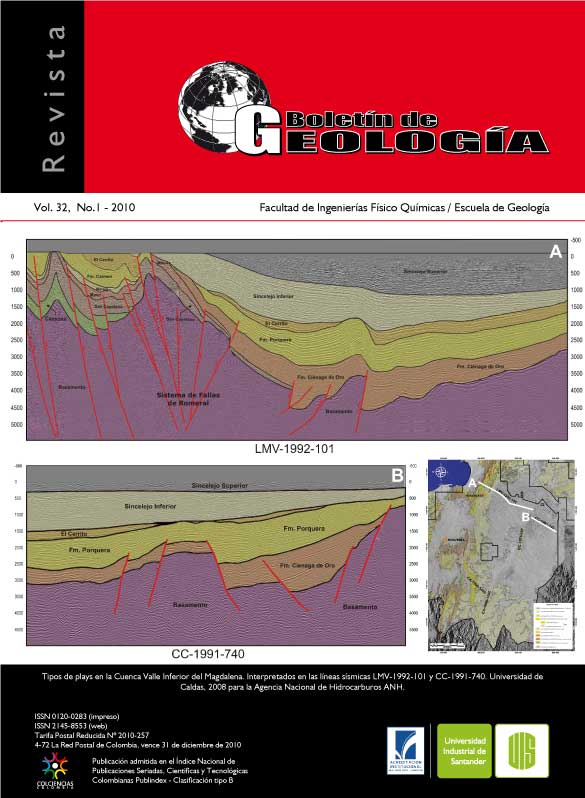Cómo citar
Resumen
RESUMEN
Asociada a la formación de los Andes de Colombia, la actual cuenca del Valle Medio del Magdalena resulta de la fragmentación de una ancestral cuenca de antepais asociada a la Cordillera Central y ahora al levantamiento por inversión tectónica de la Cordillera Oriental. Con el fin de establecer la temporalidad del levantamiento se estudió la distribución de facies sedimentarias, paleocorrientes y petrografía en las unidades cenozoicas del sector E de la cuenca. Se identificó un cambio en la dirección de paleocorrientes de direcciones hacia el N NE y E SE en las Formaciones La Paz y Esmeraldas a direcciones W NW en la formación Mugrosa, las cuales se mantienen en las unidades suprayacentes. Los datos de proveniencia indican una fuente de sedimento para La Paz y Esmeraldas proveniente de la Cordillera Central, otra para Mugrosa y Colorado de la Cordillera Oriental y ambas para Formación Real. Los anteriores análisis de información primaria de afloramientos permiten proponer el inicio del levantamiento de la Cordillera Oriental durante el Eoceno tardío - Oligoceno temprano. Basados en estas evidencias se puede inferir la deformación y configuración de trampas de petróleo al menos desde el Eoceno en la Cuenca Valle Medio del Magdalena de Colombia.
Palabras clave: Colombia, Análisis de cuencas, Paleocorrientes, Distribución de facies, Proveniencia de sedimento, Cordillera Oriental, Colombia, Conteo de clastos, Cordillera Central.
LATE EOCENE - EARLY OLIGOCENE INITIAL UPLIFT OF THE ORIENTAL CORDILLERA OF COLOMBIA: SEDIMENTARY PROVENANCE ON THE NUEVO MUNDO SINCLINE, MIDDLE MAGDALENA BASIN
SUMMARY
Associated to the Colombian Andes uplift, the present day Middle Magdalena Valley Basin resulted from the fragmentation of an ancestral foreland basin associated first to the Central Cordillera and then to the uplift by tectonic inversion of the Oriental Cordillera. To constrain the initial uplift of the Oriental Cordillera a study of paleocurrent directions, sediment provenance and facies distribution on the Cenozoic units of the E part of the Middle Magdalena Valley Basin was conducted. A drastic change in the paleocurrent directions was founded from N NE and E SE in the La Paz and Esmeraldas formations (late Eocene), toward W NW in the Mugrosa Formation (early Oligocene), which maintains in the overlying Neogene units. Petrography data indicates at least two sediment source areas, one contributing to the La Paz and Esmeraldas Formations, the other to the Mugrosa and Colorado Formations and both supplied sediment to the Real Formation. The analysis of all this outcrop data and information let us to propose an initial uplift of the Oriental Cordillera since the late Eocene to early Oligocene. From this finding we can infer deformation and oil trap configuration until at least the Eocene time in the Colombia Middle Magdalena Basin.
Keywords: Basin analysis, Paleocurrent analysis, Facies distribution, Sediment provenance, Oriental Cordillera, Central Cordillera, Colombia, Clast counting, Middle Magdalena Valley.
